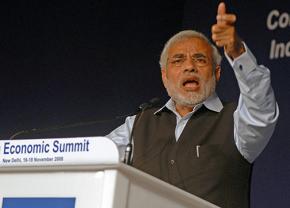Fear clouds the Indian elections
provides the background for understanding the elections in India--and the looming threat of a triumph for the Hindu right when they end this month.
IN THE lead-up to India's parliamentary elections--which began in early April and continue through mid-May--progressive intellectuals, activists and organizations sounded the alarm over the prospect of a victory for the candidate of the Hindu right, Narendra Modi.
A statement by well-known left intellectuals published in The Hindu began, "Never before in post-independence India have political forces, which are a front for an organization committed to creating a Hindu Rashtra [Nation], made as strong a bid for power as in the coming elections." Similarly, Salman Rushdie, Deepa Mehta and others warned that Modi's election "would bode ill for India's future as a country that cherishes the ideals of inclusion."
Journalist and rights activist Praful Bidwai issued an even more forceful warning:
If Modi wins, his regime is likely to be even worse [than Indira Gandhi's imposition of emergency rule in 1975-76], with systematic attacks on civil and political rights, railroading of all legitimate opposition, despotic imposition of corporate-driven economic agendas, and further militarization and communalization of society, which will lead to harassment of conscientious citizens, and outlawing and repression of dissent.

This sense of alarm is justified. Narendra Modi is a former pracharak (literally, propagandist) for the Rashtriya Swayamsevak Sangh (RSS, or National Voluntary Association), which functions as the ideological and organizational backbone of the fascist Sangh Parivar, the "family" of Hindu fundamentalist groups that includes militant cadre organizations such as the Bajrang Dal and the Shiv Sena.
The Bharatiya Janata Party (BJP, or Indian People's Party) is the parliamentary wing of the Sangh Parivar. Through the 1990s and 2000s, the BJP rose to become the largest challenger to the Congress Party, the dominant force in Indian politics from independence in 1947. Currently, the BJP leads the opposition in a parliamentary coalition called the National Democratic Alliance (NDA), while Congress leads the ruling coalition of parties called the United Progressive Alliance (UPA).
Modi's nomination as the BJP candidate for prime minister is seen by many as evidence of an RSS coup within the party, which marginalized the old guard. That old guard was made up of rabid chauvinists and authoritarians themselves, but they are now spoken of as "moderate" next to the intolerant and authoritarian Modi.
As chief minister of the state of Gujarat in Western India, Modi presided over one of the worst anti-Muslim pogroms in recent memory, when more than 1,000 Muslims were killed and more than 100,000 were forced to flee their homes in the spring of 2002.
The BJP's relationship with the RSS hasn't always been a smooth one, as the contingencies of electoral coalition politics have sometimes driven a wedge between their respective strategies for furthering the goals of Hindutva. But these are family quarrels, so to speak.
The Candidate of Choice for Capital
Modi is the choice of the RSS, certainly, but the source of his power lies in his links to big capital. He has been embraced by large sections of the Indian bourgeoisie looking to further consolidate their wealth and power in the face of an economic slowdown and increasing resistance from the working classes.
An article in the Financial Times captured the giddy enthusiasm among the business classes. "There's something thrilling about the rise of Narendra Modi," the article begins, under the headline "India Needs a Jolt--and Modi Is Risk Worth Taking."
Modi likewise appeals to a growing urban middle class whose hedonistic pursuit of consumer capitalism and starry-eyed idolization of the super-rich is matched only by its disdain for the plight (and the struggles) of the plebeian masses. As Shiv Visvanathan wrote at the RadicalSocialist.in site, "The middle class sees in Modi a decisive, security-oriented, and development-centered, urban-fixated politician who has voiced all their fears about Muslims, anarchy, security and transformed it into a huge vote bank."
The backdrop to this is the neoliberal economic reforms that began to take effect in India in the early 1990s. The goal was to restructure the economy by dismantling the bureaucratically clogged regulatory regime of previous decades--the so-called "License Raj."
Large public-sector enterprises were privatized or shut down. Special Economic Zones were set up as tax- and regulation-free havens for foreign investors. Foreign and domestic investment increased, and growth rates of 7-9 percent over nearly two decades resulted in a massive accumulation of wealth at the very top of Indian society.
According to Forbes, India's 56 billionaires have a collective net worth of nearly $200 billion, while a report in The Hindu pegs the wealth of the country's 7,850 "ultra-high net worth" individuals at $950 billion, equivalent to nearly half the country's annual GDP.
But the years of high growth rates are over. Since the onset of the global economic crisis of 2008, the Indian economy has been slowing down, and investment has plummeted from an average of about 12 percent over the last decade to nearly zero in the last two years, as economist Michael Roberts reports. Meanwhile, urban inequality is at an all-time high, and rural inequality has also gone up.
To boost its populist credentials, the Congress-led UPA government enacted a few piecemeal reforms, such as the National Rural Employment Guarantee Act, which promised to provide 100 days of wage labor for every rural household; a modest increase in food subsidies to the poor; and benign modifications to the notorious colonial-era Land Acquisitions Act.
But this watery populism has had little effect, especially after years of strong economic growth failed to close the gap between rich and poor--and a string of sensational multibillion-dollar corruption scandals involving industrialists and high-ranking government officials.
With its nepotism, ties to big business and opportunistic appeals to "vote-banks" among oppressed castes and minorities, Congress stands discredited. Modi's rise owes much to the failures of the UPA government.
As journalist Siddharth Varadarajan puts it, "Modi is where he is today--on the cusp of power--not because the country is becoming more communal, but because the Indian corporate sector is becoming more impatient." For Indian capital, the answer to a slowing economy is to trim the welfare state--by eliminating food and fuel subsidies to the poor, increasing regressive taxation and further loosening restrictions on access to land and forests for mining and resource extraction.
The way that big business turned away from Congress--now seen as "indecisive" and unreliable--and toward Modi, writes Vardharajan, is "a cautionary tale about the deep crisis that rent-seeking and cronyism have engendered in the Indian economy, now that the immediate gains made possible from liberalization have reached their natural limit."
Modi's campaign rhetoric has thus centered around themes of "development" and "good governance," with the "Gujarat model" put forward of as evidence.
But there is more shine than substance to this model. While Gujarat has the second-highest per capita income in the country, it has also seen nearly 5,000 farmer suicides in the period from 2003 to 2012. Gujarat registered the seventh-highest GDP growth among states in 2013, but it ranked 13th in terms of rural consumption growth. According to economists C.P. Chandrashekhar and Jayati Ghosh, wages in Gujarat are lower than the national average--and that of "male casual labor in Gujarat are at the bottom of the scale across India in terms of the real incomes they generate."
The Dangers Ahead
While emphasizing the "Gujarat model," Modi hasn't stayed away from explicitly Hindu nationalist themes. His speeches in the northeast of the country are telling in this respect. Here, the issue of "illegal immigrants" from Bangladesh has long been used by politicians to whip up national and ethnic chauvinism.
In a campaign speech earlier this year, Modi made the absurd allegation that the state government in Assam was killing rhinos to clear land for Bangladeshi migrants. Later, in the city of Serampore in West Bengal, Modi called for the deportation of immigrants, saying that after May 16--the day the election results are to be announced--Bangladeshis will be expected to "pack up their bags." Not all Bangladeshi immigrants, however: Hindu migrants, he says, must be welcomed and accommodated--proving that Modi's anti-Bangladeshi stance is, in fact, anti-Muslim.
The months leading up to the elections have been marked by several episodes of violence, including the Muzaffarnagar riots in August and September 2013, in which at least 62 people were killed and tens of thousands of Muslims fled their homes.
The fears of those on the left about Modi are therefore not surprising. But not everyone is sounding the alarm. Ramachandra Guha, a well-known liberal intellectual, recently wrote: "Those who fear that...Narendra Modi would inaugurate a period of 'fascist' or even Emergency-like rule in India underestimate the strength of our democratic institutions, and the robustness of our federal system."
Guha may be right that a revocation or suspension of the Constitution and the establishment of a Hindu theocracy may not be imminent. Socialist activist and scholar Kunal Chattopadhyay, however, warns against the complacency that Guha's attitude encourages--for if Guha belittles the warnings of the left as so much fear-mongering, other liberals, such as the sociologist Andre Beteille, have gone further and announced their support for Modi.
Besides, there is ample repressive capacity built into the Constitution. The continued military occupation of Kashmir, with its rampant abuse of power and subversion of the people's will, required no suspension of the Constitution in New Delhi--nor did the continued repression of adivasis and the dispossessed in Chhattisgarh and Bihar. The notorious Armed Forces Special Powers Act and numerous other repressive mechanisms allow the state plenty of latitude in dealing out repression, short of imposing martial law.
A report by Human Rights Watch points out that India is yet to ratify the Convention Against Torture and the Convention Against Enforced Disappearance: "Human Rights Watch has long documented a pattern of impunity, often permitted under Indian law." The "democratic institutions" and "robust federalism" of the Indian state coexist easily with the armed force it uses to maintain its rule in large parts of the subcontinent, not least in Kashmir.
A Modi government would embolden the already-resurgent Hindutva brigade: it would legitimize the moral policing vigilantes who physically assault women at parties and in bars, the thugs who seek to silence progressive journalists, the Khap Panchayats (village councils) that want to ban women from wearing jeans and using cell phones, the many upper-caste goons who terrorize Dalit villages and neighborhoods.
Although the economy has slowed down, Indian capital does not face insurmountable challenges to its rule from the left or the working classes at this time. It isn't about to ditch democratic constitutionality and hand over the reigns of state power to the Praveen Togadias and Baba Ramdevs just yet.
Still, while the imposition of a fascist regime from above may not be imminent, the cadres of the Sangh Parivar will be strengthened by a Modi victory. Confronting and resisting these forces is an ongoing challenge for the left.
Is There an Alternative?
It needs to be said that the so-called "Modi wave" is largely media-driven and a reflection of the deep pockets of Modi's campaign--as well as the steady dance of journalists to the tune of their corporate sponsors and owners.
At the time of this writing, reports from activists in Varanasi, where Modi is running for election to parliament, suggest that among workers and oppressed castes, Modi's support is quite thin. Similarly, in Uttar Pradesh and Bihar, two states where the BJP must win big, the wave might not have actually materialized.
While the sense of consternation, even panic, at the prospect of a Modi win among progressives in India is palpable, most of the election reports have understated the significance of resistance to neoliberalism and its effects. The spectacular accumulation of wealth at the very top of Indian society--what Arundhati Roy refers to as the "gush-up" economy--was enabled by the policies of both Congress-led and BJP-led national governments, so there has been a remarkable continuity of economic policies throughout this period.
On the other side, there has been pushback against the priorities of neoliberalism: from the rebellions against land acquisition in Nandigram and Singur, to the growing industrial struggles in the auto plants of the Delhi/NCR region, to the general strikes in 2010, 2012 and 2013; to anti-nuclear power protests in Mithi Virdi and Kudankulam.
But these struggles have not as yet been able to turn the tide. Workers in the auto plants faced terrible repression, and many militant trade unionists have been languishing in jail for nearly two years (though despite this, the Maruti Suzuki Workers Union scored a major victory recently by pushing back the bosses' attempt to set up a puppet union).
The general strikes, announced and led largely from above, have not done enough to bolster union density or workers' self-organization on the ground. The heroic struggle against the Kudankulam nuclear plant failed to halt its construction, and its most prominent leader, S. P. Udayakumar, was forced to go into hiding after he was charged with sedition for leading the protests.
While these struggles point to the potential for a working-class alternative, they have so far not been able to pose a serious challenge to bourgeois politics.
The emergence of the Aam Aadmi Party (AAP) shows how alienated people are from the BJP and the Congress.
AAP is a party rife with contradictions (like any other bourgeois reformist party)--a big tent that might not be able to retain its internal cohesion. But its mass support speaks to the hunger for change. Tens of thousands, if not hundreds of thousands, of urban youth have become politicized, broken with long-standing allegiances to dynastic politics and are learning the ins and outs of activism and organization.
If the AAP's anti-corruption platform has garnered support among progressive activists, it is because the organized left remains weak and fragmented. The parliamentary left, led by the Communist Party of India (CPI) and the Communist Party of India (Marxist) (CPI-M), is in disarray, its forces licking their wounds after a humiliating defeat in West Bengal in the last elections.
While in power in the West Bengal state government, the CPI-M projected itself as a more "reliable" ally for Western multinationals, evicting nearly 100,000 slum-dwellers from the streets of Kolkata (Calcutta), increasing restrictions on trade unions to prevent strikes and job actions, and hiring the American public relations firm McKinsey & Company to boost its image abroad. The CPI-M proved itself a willing accomplice in the neoliberal racket--and was punished for it at the polls in 2011.
Moreover, far from posing an alternative to bourgeois politics, the CPs have actively encouraged Great Indian nationalism and the "Idea of India" that approves of the neo-colonial Indian occupations of Kashmir and Manipur. In the anti-caste struggle, the CPs have been weak allies at best, having actively adopted, or turned a blind eye towards, caste within their own ranks.
Outside the CPs, there is a small but growing and vibrant left, with an increasingly visible presence on picket lines of striking workers, in rural mobilizations against nuclear power, on campuses supporting Dalit students' rights, and in street protests for women's rights and against rape.
The non-Stalinist left faces a formidable task if Modi wins. Building revolutionary organizations that can offer an alternative to capitalism, communalism and the caste system will become more difficult under a Modi regime. But this emerging left, and the diverse struggles it is involved in, offers hope amid one of the most disturbing elections in Indian history.
Many thanks to Tithi Bhattacharya, Phil Gasper, Pranav Jani and Snehal Shingavi for critical comments on earlier drafts of this article.


